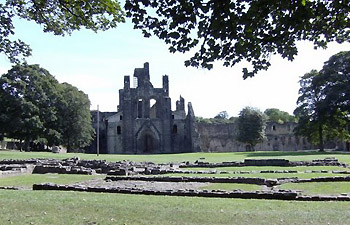
Following a Monk’s Life
by Marc Latham
I am sitting in the tranquil green grounds of Kirkstall Abbey, with the medieval building to one side and swans gliding somewhere between the River Aire, the lowering sun to the other. It isn’t difficult to imagine why the Cistercian monks chose to build their new community here in the twelfth century.
The abbey was one of eight built by the Cistercians in Yorkshire after the monks expanded northwards from France. They had previously broken away from the Benedictine order because they did not consider them pious enough.
Aire Valley was a very different place at that time. The abbey community was situated in a wooded hamlet separate from any other civilisation. The forest provided wood for construction, while stone from a local quarry and water from the River Aire provided the other vital materials needed to build the church, cloister and community buildings. This was completed before the first abbot, Alexander, died in 1182.
Over the centuries the city of Leeds has expanded to the north-eastern edge of the abbey grounds, and the busy Abbey Road now passes to the north of the church. The main thoroughfare to Leeds actually passed through the nave after the monks were removed during the dissolution of the monasteries ordered by Henry VIII in the sixteenth century. However, the abbey and its beautiful grounds drew the attention of Romantic artists such as John Turner in the 1800s, and it was restored by the council during the next century. The road was outside the grounds when it opened to the public in 1895. The museum and car park are across the road from the abbey, on the site of the abbey complex’s original inner gate.
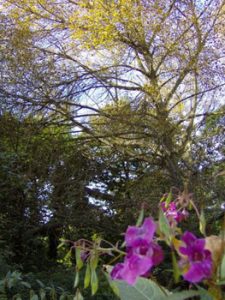 I approached on foot from Leeds, via Bridge Road on the eastern side of the Abbey. Entering the grounds just above a war memorial, there is a scenic walk that takes you along a mill race, or as it is known locally, a goit: a stream that is thought to have been diverted from the Aire by the monks to power their corn mill.
I approached on foot from Leeds, via Bridge Road on the eastern side of the Abbey. Entering the grounds just above a war memorial, there is a scenic walk that takes you along a mill race, or as it is known locally, a goit: a stream that is thought to have been diverted from the Aire by the monks to power their corn mill.
Along the walk I passed a wildflower meadow that features plants as colourful as their names, such as Birdsfoot Trefoil and Hay Rattle. Red Admiral and Painted Lady butterflies flutter between the flowers, and birds like the Grey Wagtail, which is noticeably yellow, also brighten the path. After dusk, Pipistrelle and Daubenton bats take over the sky.
After crossing the goit via a wooden bridge the abbey comes into view, with the tower’s size making the first impression, followed by the haunting historic splendour of the whole abbey, and the idyllic setting. Austerity meant the monks’ church did not have such a majestic tower, and theirs is thought to have been only a little higher than the nave roof; the present tower was added in the sixteenth century.
Tall trees line the approach. The tarmac path meanders up and down, left and right, before reaching the abbey. To my left, mute swans and goosander ducks above and below the weir on the River Aire seem to be enjoying the sun as much as the people feeding them.
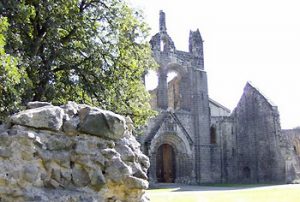 After passing along the southern side of the abbey I turn to my right, past the visitor centre on my way to the nave. There are free guided tours from the visitor centre each Thursday, as well as information, refreshments and amenities both there and in the museum.
After passing along the southern side of the abbey I turn to my right, past the visitor centre on my way to the nave. There are free guided tours from the visitor centre each Thursday, as well as information, refreshments and amenities both there and in the museum.
Entering the nave, where the monks used to pray, made me wonder what it must have been like for them, waking for the first service at 2am, and then diligently going about their studies through the dark morning. They did this right through the winter too, with each monk only allowed ten minutes a day in the warming room.
As I walked the 200 feet length of the nave past eight columned arches to the tower and presbytery, the shade provided by the high roofless walls seemed to noticeably lower the temperature. As if the sun was trying to enter and warm the room, rays of light filtered through a spider’s web on one of the gates to the cloister, illuminating the intricate weaving that had created it. Overhead, pigeons flew from nave to presbytery, and between transepts either side of the tower; the four points that give the church its cruciform shape.
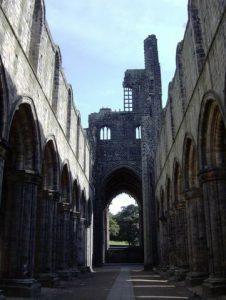 Exiting the nave via the south transept I enter the cloister which features a stone walkway framing a verdant lawn. There was an orchard there in its heyday, and the inhabitants would work or relax on the grass. The monks also ritually bathed their feet each Saturday for Maundy in the cloister, and used the wall basins for general washing. It was nice to be bathed in warm sunshine again after only being out of it for half an hour, so I imagine the monks must have looked forward to spending time there in the spring and summer.
Exiting the nave via the south transept I enter the cloister which features a stone walkway framing a verdant lawn. There was an orchard there in its heyday, and the inhabitants would work or relax on the grass. The monks also ritually bathed their feet each Saturday for Maundy in the cloister, and used the wall basins for general washing. It was nice to be bathed in warm sunshine again after only being out of it for half an hour, so I imagine the monks must have looked forward to spending time there in the spring and summer.
I stroll around with the lawn to my right, passing the chapter-house and parlour on my left, with the monks’ dormitory above them. Confessions took place in the chapter-house each Sunday, and there were also daily readings from the rule of St. Benedict there. The parlour was the only place that the monks were allowed to speak. The abbot’s lodgings and infirmary were behind the parlour and chapter-house, but due to safety precautions they are only accessible on guided tours at the moment.
Continuing to circle the cloister, I pass the warming house, before the refectory, the malt house and lay-brothers’ dormitory. The abbey was divided between the educated Latin-speaking monks and the lay-brothers, who did the labouring and domestic chores; it was apparently quite a rigid segregation, with even space on the cloister lawn divided very much in the monks’ favour.
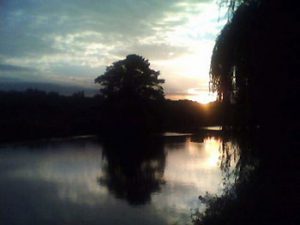 After exiting via the nave, a short walk took me to the location of the guest house, although only the foundations remain. It is thought there was also a forge, stable, bakery and infirmary on the site.
After exiting via the nave, a short walk took me to the location of the guest house, although only the foundations remain. It is thought there was also a forge, stable, bakery and infirmary on the site.
Further west on the abbey road, there are panoramic views across picturesque green fields between Horsforth and Rawdon; and just past the airport there is the Chevin Forest Park, where the 925 feet high ridge was part of a Roman road linking the towns of Otley, Ilkley and Tadcaster.
On this occasion I returned to a wooden riverside seat to the south of the abbey, and as the inhabitants of the abbey did 800 years before, I watched the sun set over the Aire.
If You Go:
Entrance to the Abbey and Museum:
Entrance to the abbey is free, and there are free guided tours on Thursdays. Please ring 01132305492 to book.The Abbey Museum is open at the following times: Monday closed all day, Tuesday to Friday 10am – 5pm, Saturday 12noon – 5pm, Sunday 10am – 5pm. Admission charges apply: Adults £3, Concessions £2 (senior citizens and students), Children £1 (16 and under), Family ticket £5 (2 adults and up to 3 children).
Travel to Leeds and Kirkstall Abbey:Leeds-Bradford international airport has regular flights to many airports in the UK and Europe, and has just started providing long-haul flights.
Information at: www.lbia.co.uk
Being at the centre of the UK, and the transport system, means Leeds has regular buses and trains to the north and south.
For details of buses visit: www.nationalexpress.com
For details of trains visit: nationalrail.co.uk
The 757 bus links the airport with the centre of Leeds, and travels past Kirkstall Abbey. The 33 bus service also runs from the centre of Leeds to the abbey. Both buses have very scenic routes. A one-way bus ticket from Leeds centre to the abbey will cost between £1.50 and £2. Day-rider tickets for all day travel in the Leeds area are available for £2.70.
For the times of buses see: www.firstgroup.com
Accommodation:
Leeds offers a multitude of accommodation possibilities, from cheap and cheerful ‘bed and breakfasts’ to expensive five star hotels.
For more information visit: www.yorkshire.com
Further information on Kirkstall and the abbey at:
www.leeds.gov.uk
cistercians.shef.ac.uk
www.vrleeds.co.uk
www.kirkstall.org.uk
Tours from Leeds Now Available:
Private Group Yorkshire Dales Day Trip from Leeds
Private Group North York Moors and Whitby Day Trip from Leeds
Private Group Haworth, Bolton Abbey and Yorkshire Dales Day Trip from Leeds
About the author:
Marc Latham travelled to all the populated continents between 1987-1994. From 1995-2005 he studied for a BA in History and an MA and PhD in Communications Studies. He is now trying to build a career as a freelance writer from the www.greenygrey.co.uk website.
Contact: marc@greenygrey.co.uk
Photographs:
All photos by Marc Latham.



Leave a Reply
You must be logged in to post a comment.